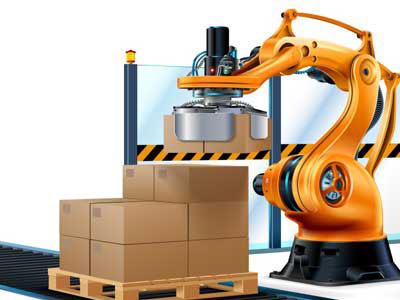Key Takeaway
The purpose of industrial robots is to automate repetitive and intensive production tasks. They are designed to improve efficiency, precision, and safety in manufacturing processes. Industrial robots handle tasks like welding, painting, assembly, and packaging. By performing these tasks, they reduce human error, increase production speed, and enhance product quality. These robots are usually placed in fixed positions on the production line, allowing workers to focus on more complex tasks. Overall, industrial robots help streamline operations and boost productivity in industrial applications.
Automating Manual Tasks
Automating manual tasks revolutionizes efficiency in industrial operations. By integrating advanced automation solutions, IndMALL streamlines production processes, enhances accuracy, and reduces labor costs. Our range includes cutting-edge products like Omron’s safety light curtains, Leuze’s sensors, and Autonics’ controllers, ensuring robust performance across diverse applications. With a focus on innovation and reliability, we empower businesses to optimize their workflows and achieve higher productivity standards. Explore how our tailored automation solutions can elevate your operations to new heights of efficiency and profitability.

Increasing Production Efficiency
One of the primary purposes of industrial robots is to increase production efficiency. Robots can operate at high speeds and with a level of precision that is difficult to achieve manually. They are programmed to execute tasks quickly and accurately, reducing cycle times and increasing throughput. This efficiency is particularly valuable in industries such as automotive manufacturing, electronics, and pharmaceuticals, where high-volume production is essential. Additionally, robots can work around the clock without breaks, significantly boosting productivity and meeting demanding production schedules.
Their ability to maintain a consistent pace without fatigue ensures that production lines run smoothly, minimizing downtime and maximizing output. This relentless efficiency helps companies stay competitive in fast-paced markets, ensuring they meet customer demands effectively. Furthermore, robots can be reprogrammed for different tasks, providing flexibility in production processes and enabling rapid adaptation to changing market needs. The combination of speed, precision, and adaptability makes industrial robots indispensable in modern manufacturing.
Enhancing Product Quality
Industrial robots play a crucial role in enhancing product quality. Their ability to perform tasks with high precision ensures that each product is manufactured to exact specifications, reducing the likelihood of defects and variations. Robots are equipped with advanced sensors and vision systems that allow them to detect and correct errors in real-time. This capability is especially important in industries where quality control is critical, such as aerospace and medical device manufacturing.
By maintaining consistent quality standards, robots help companies meet regulatory requirements and customer expectations, ultimately leading to higher satisfaction and reduced returns. The consistent quality provided by robots also enhances the reputation of manufacturers, as they can guarantee uniformity and reliability in their products. This not only satisfies customers but also builds trust and loyalty, which are essential for long-term business success. The use of robots in quality control thus ensures that products are safe, effective, and of the highest standard.
Reducing Human Error
Human error is a common cause of defects and inefficiencies in manufacturing processes. Industrial robots help mitigate this risk by executing tasks with a high degree of accuracy and repeatability. Unlike humans, robots do not suffer from fatigue, distractions, or inconsistencies, which means they can perform the same task flawlessly over and over again. This reduction in human error leads to fewer product defects, lower scrap rates, and reduced rework, which in turn saves time and costs.
By minimizing the impact of human error, robots contribute to a more reliable and efficient production process. This reliability is crucial for maintaining product quality and meeting production targets. Additionally, the precision of robots allows for the handling of delicate tasks that require steady hands, further reducing the risk of errors. The use of robots not only enhances efficiency but also ensures that the products meet the highest standards of quality, ultimately benefiting both manufacturers and consumers.
Improving Safety Standards
Safety is a paramount concern in industrial settings, and robots significantly enhance safety standards. They perform hazardous tasks that are dangerous for human workers, such as handling toxic materials, operating in extreme temperatures, and working around heavy machinery. By taking over these risky tasks, robots help prevent workplace injuries and create a safer working environment.
Robots are equipped with advanced safety features like collision detection and emergency stop functions, which further improve workplace safety. These features allow robots to operate seamlessly alongside human workers, reducing the risk of accidents. The implementation of robots in manufacturing processes not only protects workers but also ensures compliance with stringent safety regulations, which is crucial for avoiding legal issues and maintaining a safe work environment.
The use of robots in hazardous environments highlights the importance of technological advancements in industrial safety. By mitigating risks and enhancing protective measures, robots contribute to a secure and efficient workplace. This allows employees to focus on their tasks without unnecessary risks, promoting overall well-being and productivity. The continuous integration of robots in industrial operations demonstrates a commitment to creating safer, more efficient work environments, ultimately leading to higher safety standards and better compliance with safety regulations.
Conclusion
Industrial robots serve to enhance efficiency and precision in manufacturing processes, reducing labor costs and improving product quality. They handle tasks ranging from assembly to welding with consistency and speed, crucial in industries striving for automation. By minimizing human error and ensuring continuous operation, these robots not only boost productivity but also enable businesses to meet growing demands effectively. Thus, their integration proves pivotal in modern industrial settings for achieving heightened operational standards.
